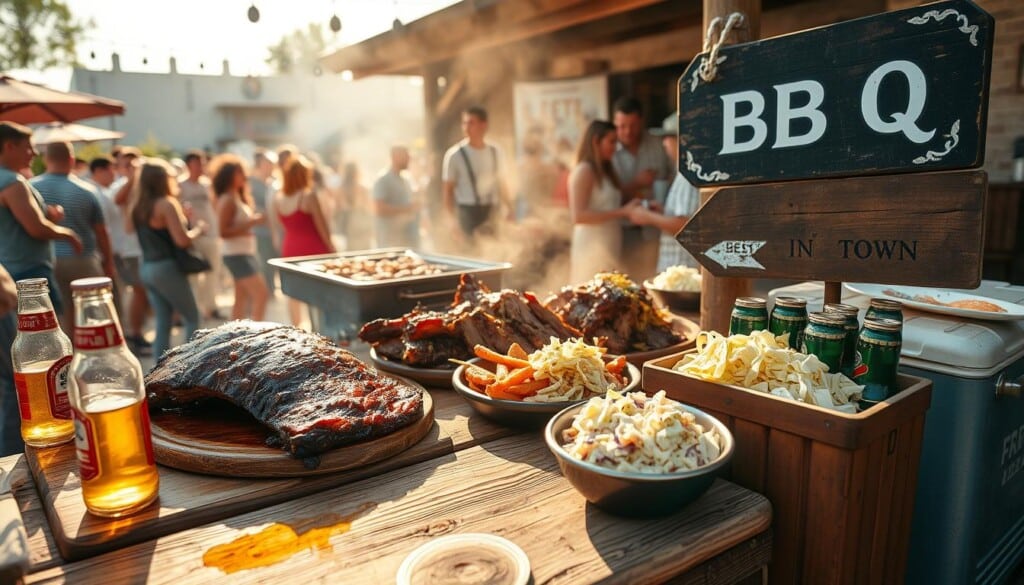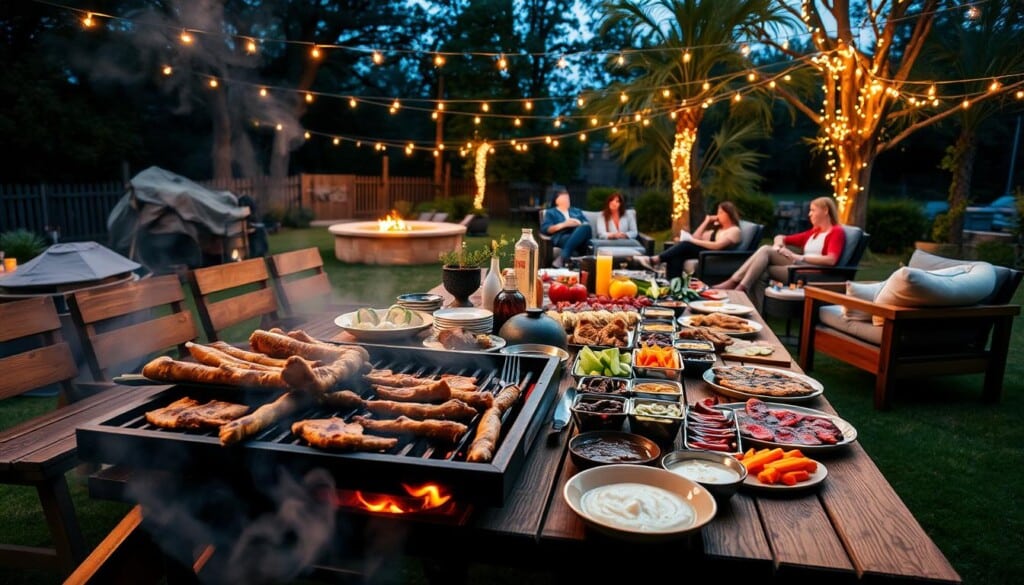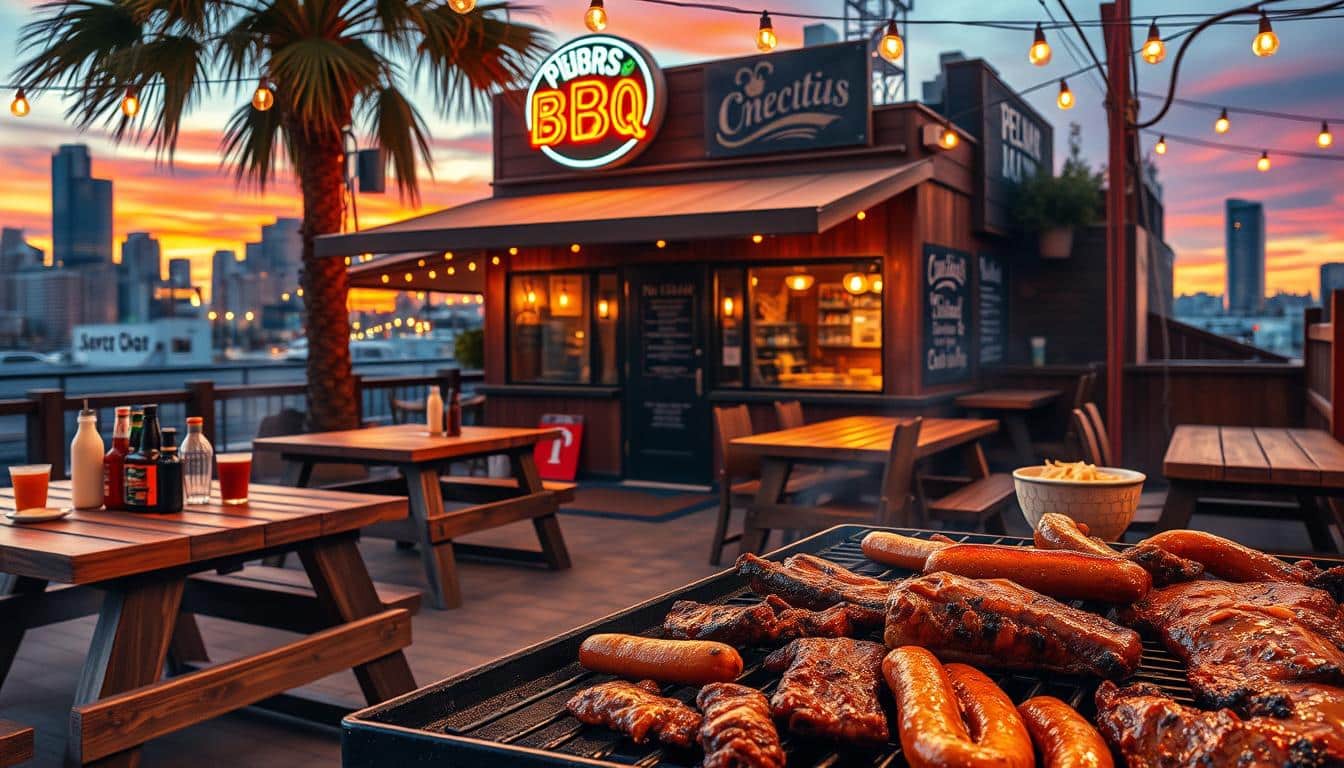What if your perfect outdoor cooking experience was just a store away? The world of barbeque stores in the United States is more than just a marketplace. It’s a vibrant tapestry of culinary tradition, innovation, and community connection.
The barbeque restaurant industry is a huge $4 billion segment. It thrives in regions known for their unique BBQ styles, like Texas, Kansas City, the Carolinas, and Memphis. Exploring these regional nuances and finding the best BBQ restaurants will make your outdoor cooking adventures better. It will also guide you to premium BBQ supplies for every occasion.
Key Takeaways
- Explore a variety of barbeque stores with unique regional styles.
- Discover the importance of quality BBQ supplies for outdoor cooking.
- Understand the significance of supporting local barbeque restaurants.
- Learn how barbeque has evolved into a multimillion-dollar industry.
- Find tips on sourcing the best BBQ restaurants in your area.
Introduction to Barbeque Stores
Barbeque stores are a big deal in American culture. A top barbeque store does more than just serve food. It offers quality ingredients, a wide range of sauces, and great service. Stores that focus on local flavors make dining a special experience for the community.
What Defines a Great Barbeque Store?
A great barbeque store uses high-quality meats like brisket and ribs. It also has unique sauces made in-house. Friendly staff make a big difference, making customers want to come back. It’s all about blending old traditions with new flavors.
Why Barbeque is a Popular Cuisine in the U.S.
Barbeque is loved in the U.S. because it brings people together. It’s perfect for social events, where everyone enjoys smoked meats and sides. It started as a way to cook tough meats but now it’s a beloved tradition. You can find the best local barbeque spots with help from LocalZ.
How LocalZ Supports Your Search for Barbeque Stores
LocalZ is a key tool for finding local barbeque stores. It changes how we connect with our communities and find great BBQ. The platform makes it easy to find your favorite BBQ spots by gathering all the info you need.
Introducing LocalZ: Revolutionizing Local Business Connectivity
LocalZ helps you find local BBQ through a detailed directory. This makes finding barbeque places easy and efficient. It shows off what each BBQ place offers and how they help the community.
Each listing helps businesses get noticed and supports the local economy. This creates a strong community bond.
Benefits of Using LocalZ for Your Local Searches
Using LocalZ for BBQ searches has many benefits. You get easy access to reviews, menus, and exact locations. This helps you choose the best BBQ places.
The focus on community engagement strengthens the bond between local businesses and residents. It makes the community feel closer and more connected.

The Step-by-Step Process to Find Barbeque Stores
Finding the right barbeque store can be rewarding. A structured approach makes it easier. The Step-by-Step BBQ Search helps you find great barbeque easily. LocalZ offers Online BBQ Listings, making it simple to find delicious food for any occasion.
Step 1: Search for Barbeque Listings
Start by searching for barbeque listings in your area on LocalZ. This platform lets you filter by cuisine or user ratings. It’s easy to make a list of places you’d like to try.
Step 2: Choose the Right Barbeque Spot
Once you have your list, pick the spot that sounds best. Look at reviews, menus, and photos. This way, you’ll have a great time at your chosen barbeque place.
Discovering Unique Barbeque Styles
In the world of BBQ, each region in the United States has its own special style. These styles are shaped by local traditions and tastes. Exploring these differences shows us unique flavors and cooking ways that make BBQ special.
Regional Barbeque Styles to Explore
Texas is famous for its brisket, known for its smoky taste and tender texture. Kansas City ribs are loved for their thick, sweet sauces. The sauces in Carolina vary, from vinegar-based to mustard-based, pleasing many tastes.
Memphis is known for its pulled pork, seasoned with a special dry rub. It’s often served with tangy sauces. Each style shows the diversity and skill in BBQ, making it a favorite dish.
Notable Barbeque Techniques and Trends
Modern BBQ Techniques are changing, with a focus on smoked meats for extra flavor. Gourmet BBQ sauce pairings are also popular, adding complex tastes to meals. Healthier options like plant-based BBQ are becoming more popular, appealing to those looking for different choices.
These changes show how BBQ is evolving to meet new tastes. It’s making the BBQ world bigger and more exciting.
Top Regions for Barbeque Stores in the U.S.
The BBQ Regions in the U.S. offer a wide range of flavors and cooking styles. These areas show the diversity of American barbeque culture. Knowing about these regions helps fans understand the different tastes and methods used across the country.
Southern Barbeque Hotspots
Southern BBQ is a key part of American food, with Texas, North Carolina, and Tennessee at the forefront. Texas is famous for its brisket, smoked for hours until it’s incredibly tender. North Carolina is known for pulled pork, seasoned with vinegar-based sauces that bring out its natural taste.
Both places celebrate slow-cooked, hearty meals that are at the heart of Southern BBQ. They invite fans to dive into their rich culinary history.
Midwest Barbeque Gems
The Midwest BBQ scene offers its own special flavors and cooking methods. Here, you’ll find a variety of meats like ribs, chicken, and sometimes fish, all covered in a thick, sweet sauce. Kansas City is famous for its wide range of sauces and cooking styles, providing a variety of tastes.
A visit to the Midwest shows how BBQ is shaped by local culture. It’s a mix of tradition and new ideas, making for a unique BBQ experience.
Barbeque Store Highlights: Local Favorites
In the world of barbeque, some places are true local favorites. They are known for their amazing food and dedication to quality. Many have won awards, showing their skill in BBQ.
These spots mix tradition with new ideas, making every visit special. Places like Dickey’s Barbecue Pit and Corky’s Ribs & BBQ are known for their Award-Winning BBQ. They keep customers coming back for more.
Award-Winning Barbeque Joints
Many award-winning BBQ joints have popped up across the country. They are known for their local flavors and traditional cooking. This makes them stand out from others.
Food lovers and competitions have recognized their hard work. They create dishes that many BBQ fans love.
Popular Local Chains Worth Trying
There are also popular BBQ chains that are loved by many. They reflect local tastes but offer consistent quality. These chains make BBQ a community event.
Visitors can enjoy a great atmosphere and a wide menu. It showcases the best in BBQ.

Supporting Local Business with LocalZ
LocalZ is a key platform that highlights the value of Supporting Local Businesses. It connects users with local barbeque stores and boosts Community Growth. This effort benefits both businesses and the community.
How LocalZ Contributes to Community Growth
LocalZ puts a lot of effort into local initiatives. It promotes local businesses, which helps the economy grow. This leads to more jobs and better neighborhoods.
LocalZ shows how community engagement leads to growth. It encourages people to support their local economy.
The Impact of Business Listing Fees Shared Locally
LocalZ is known for sharing 50% of its listing fees with local causes. This funding supports community programs and initiatives. It shows that helping local businesses helps the community too.
This approach shows LocalZ’s commitment to making a difference. It’s a way to ensure lasting impact.
Enhancing Your Dining Experience
Improving your barbeque dining is more than picking tasty meats. It’s about choosing the right sides, drinks, and portion sizes. These elements enhance the flavors and enjoyment of your meal.
When it comes to BBQ dining tips, try different sides like coleslaw, baked beans, and cornbread. These sides add variety and contrast to the smoky taste of barbeque. Serving the right amount ensures everyone leaves happy and not too full.
For easier meal planning, consider using LocalZ. It makes booking your favorite barbeque places simple. This way, you can enjoy your meal without worrying about long wait times.

Customer Reviews: Trustworthy Insights
Customer reviews are key when picking a barbeque store. Real feedback from others shows the quality and service of different places. This helps people decide where to get barbeque based on what others say, making better choices.
Importance of Customer Reviews in Your Decision
Reviews are a big help when looking for good BBQ. They point out the best spots and any areas for improvement. By reading what others say, you can find places with great food and service. This way, you make choices based on real experiences.
How to Leave a Review on LocalZ
It’s easy to leave a review on LocalZ. Just go to the barbeque place you want to review and click on the review button. Share your experience to help others and support local businesses. Your feedback adds to the wealth of information for everyone.
Engaging with Local Barbeque Events
Joining Local BBQ Events is a great way to dive into the lively world of barbeque. These gatherings, whether they’re friendly competitions or community meetups, bring people together. They let everyone enjoy unique tastes and learn new cooking skills.
Meeting other BBQ fans at these events makes the experience even better. Sharing stories and tips with them strengthens the community bond. Each event is a chance to see local talent, try new recipes, and discover exciting cooking methods.
Conclusion: Find Your Ideal Barbeque Store Today
Supporting local barbeque stores is key for community and economy. They offer great food and help keep local traditions alive. By choosing to shop at these places, we help our neighborhoods grow and stay strong.
Importance of Supporting Local Barbeque Stores
Visiting a local barbeque store shows support for local skills and family businesses. It helps keep jobs and boosts the local economy. Plus, it lets us enjoy unique barbeque styles from all over the country.
These stores also offer a chance to connect with our community and share cultures.
Start Your Search with LocalZ Now!
LocalZ is where your barbeque adventure starts. It helps you find the best local dining spots. With LocalZ, you get a list of top barbeque stores for outdoor cooking.
Find expert tips and reviews to match your taste. Begin your search today and help keep local barbeque alive with LocalZ.

